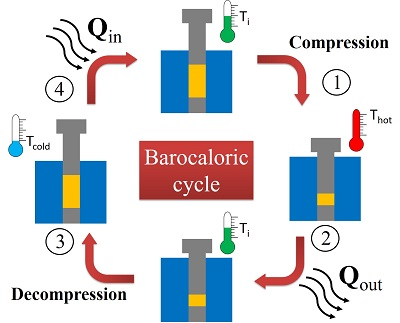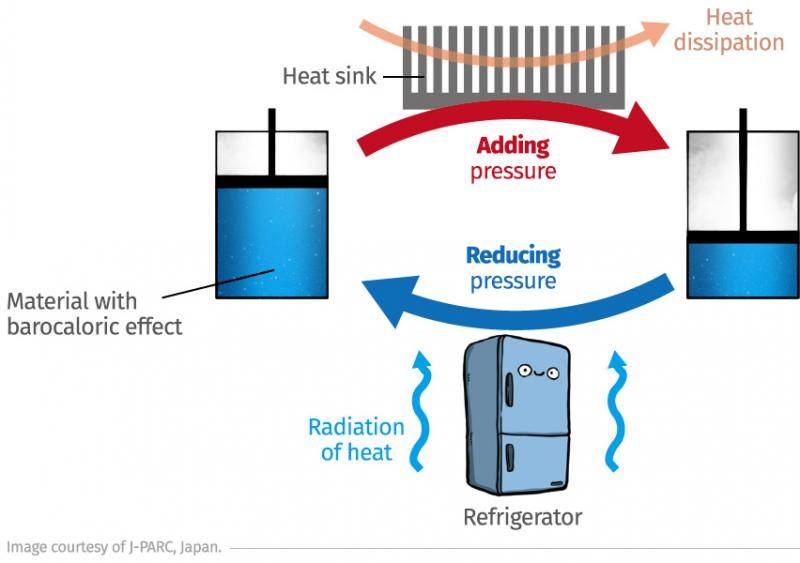Table of Contents
In a world striving to combat climate change and reduce greenhouse gas emissions, scientists are exploring revolutionary ways to make cooling systems more energy-efficient and environmentally friendly. One such breakthrough is the Barocaloric Effect (BCE)—a promising alternative to conventional refrigeration technologies. Let’s dive into what BCE is, how it works, and why it holds immense potential for sustainable cooling solutions.
What is the Barocaloric Effect?
The Barocaloric Effect (BCE) refers to the thermal changes in specific materials induced by variations in pressure. In simpler terms, certain materials heat up when pressure is applied and cool down when the pressure is released.
This reversible heating and cooling behavior is not only fascinating from a scientific perspective but also holds the key to developing solid-state refrigeration systems that can replace traditional gas-based air conditioners and refrigerators.

Materials Exhibiting Barocaloric Effect
The barocaloric effect has been observed in plastic crystals, a class of materials known for their:
-
Soft and waxy texture
-
Solid-state nature
-
Rotating molecules that can change behavior under pressure
These plastic crystals are solid refrigerants that do not require compressible gases, unlike hydrofluorocarbons (HFCs) or other greenhouse gas-emitting coolants used in traditional systems.
Temperature Range and Efficiency
One of the most notable characteristics of BCE materials is their wide temperature variation. Depending on the pressure applied, the temperature of these materials can change by over 50°C (90°F).
Additionally, barocaloric materials are more energy-efficient than current gas-compression systems because:
-
No energy is wasted in compressing and expanding gases.
-
The pressure changes can be controlled more precisely.
-
The system can operate at lower mechanical complexity and with fewer moving parts.
Key Advantages of the Barocaloric Effect
1. Eco-Friendly and Non-Toxic
-
BCE materials do not emit greenhouse gases.
-
They replace harmful refrigerants like CFCs, HCFCs, and HFCs that damage the ozone layer and contribute to global warming.
2. No Leakage
-
Since BCE systems use solid refrigerants, there is no risk of leakage as with traditional gas-based systems.
3. Higher Energy Efficiency
-
Solid-state BCE systems are more efficient and require less energy to achieve the same cooling effect.
4. Scalable Technology
-
BCE can be applied in a range of applications, from household air conditioners to large-scale industrial cooling systems.
Potential Applications of BCE Technology
-
Domestic Refrigerators & Air Conditioners
-
Data Center Cooling
-
Electric Vehicle (EV) Battery Thermal Management
-
Medical Cooling Systems
-
Space and Aerospace Applications
As research continues, BCE systems are expected to become a cornerstone of next-generation sustainable cooling.
Challenges Ahead
While the barocaloric effect is highly promising, there are some challenges that need to be addressed:
-
Developing durable materials that can withstand repeated pressure cycles.
-
Designing compact and affordable pressure-based systems.
-
Scaling up manufacturing processes for mass adoption.
Conclusion
The Barocaloric Effect represents a groundbreaking shift in how we think about cooling technology. By leveraging pressure-induced temperature changes in solid materials, BCE offers an eco-friendly, efficient, and leak-proof alternative to traditional gas-based refrigeration.
As the world pushes toward net-zero emissions and sustainable living, technologies like BCE will play a pivotal role in reshaping our energy landscape.


 Punjab PCS Question Paper 2025 Out: Down...
Punjab PCS Question Paper 2025 Out: Down...
 Punjab PCS Answer Key 2025 (Out Soon): G...
Punjab PCS Answer Key 2025 (Out Soon): G...
 JKPSC Question Paper 2025 Out: Download ...
JKPSC Question Paper 2025 Out: Download ...

























